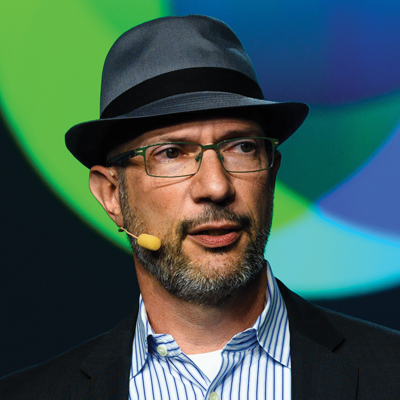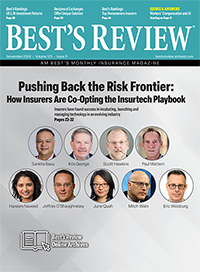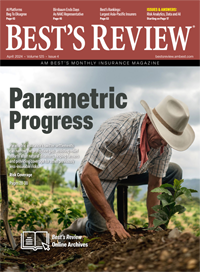The View to 2022
The View to 2022: Insurers Face New Year With Cautious Optimism
In the year ahead, insurers see plenty of challenges, including cyberrisk, growing catastrophe losses and lingering impacts of COVID-19. But, surprisingly, not all is gloomy.
Key Points
- Escalating Risks: The industry says it’s better prepared to face the escalating risks—particularly in property and casualty—that will likely continue to challenge it next year.
- Dealing With Risk: “Dealing with risk” has become the operative phrase for insurers as the costs and impacts of cyberattacks and natural catastrophes reach new heights.
- Rising Costs: A deep winter freeze, hailstorms and wildfires contributed to insured natural catastrophe losses of $40 billion in the first half of 2021, according to the Swiss Re Institute. That figure is above the previous 10-year average of $33 billion and the second highest on record for a first half after 2011.
“Stormy” may be an appropriate metaphor to use for an insurance industry that's potentially facing an increasing number of perils heading into 2022. But the forecast may not be as gloomy as you may think, industry leaders and analysts say.
As the market appears ready to manage the effects of the COVID-19 pandemic, insurers and analysts believe the industry is better prepared to face the escalating risks—particularly in property and casualty—that will likely continue to challenge it next year. AM Best analysts said the industry overall is “well capitalized” to support these challenges, although some market segments may face a new-normal level of pressures.
“Personal auto insurers are already experiencing a return to pre-COVID frequency levels while facing higher loss costs,” said Michelle Baurkot, director at AM Best.
“Dealing with risk” has become the operative phrase for insurers as the costs and impacts of cyberattacks and natural catastrophes reach new heights. Insurers looking to mitigate exposure and build resilience have found opportunities in two areas heading into 2022: technology and public-private partnerships.
Caribou Honig, chairman and co-founder of InsureTech Connect and a partner at SemperVirens Venture Capital, pitched insurtechs, automated technology and big data as forces that can help the industry ease through tough waters over the next year.
“It's hard to argue that risk is doing anything but increasing around the world as we go into 2022. The more risk lurking around corners, the more need and opportunity for the insurance industry,” Honig said. “There is a lot of reason for optimism if, but only if, insurance providers can price and manage the risk well.”

It’s hard to argue that risk is doing anything but increasing around the world as we go into 2022. The more risk lurking around corners, the more need and opportunity for the insurance industry.
Caribou Honig
InsureTech Connect
Impact on Rates
Like other insurers, Keith Wolfe, president of U.S. Property & Casualty at Swiss Re, said he characterizes his outlook as “cautiously optimistic” as he sees primary rates adjusting for real risk across almost all classes of business.
Baurkot said “many auto writers experienced premium declines in 2020 as they chose to return premiums to policyholders at the peak of lockdown during the pandemic to reflect lower miles driven.” She also said homeowners writers, who have been pushing higher rates to offset catastrophe losses and increased reinsurance pricing, took a pause in 2020 “being mindful of the economic uncertainty and financial distress facing many policyholders.”
“In 2021, both lines are experiencing premium increases, largely through rate as primary carriers focus on rate more accurately matching risk,” she said. “We've seen everything in the last two to three years—hurricanes, wildfires, hail events, winter storms and more significant wind events.”
“Primary insurance companies are saying we need to have more rate for these risks to reflect the exposure of near-term events,” she added.
On the reinsurance side, Baurkot said, primary companies “are facing escalating reinsurance costs, even in non-cat areas.”
“It becomes more challenged depending on the state-specific exposures and recent storm activity,” she said.
Wolfe acknowledges there are looming questions involving the impact of secondary perils particularly in states that have been hit the hardest by natural catastrophes, such as Louisiana and California, where floods and wildfires, respectively, continue to present a threat.
“Is that promising rate momentum actually enough for some of the trends on the loss-cost side that have been changing over time?” he said. “If you use the example of secondary perils in the catastrophe market, that is clearly something that has become a much bigger issue over the last five years than it had ever been prior to that based on the data we have analyzed.”
Jennifer Marshall, director at AM Best, also said that on the casualty side, claims inflation and social inflation are driving up claims frequency and severity.
“As a result, commercial lines insurers are increasing rate level, substantially in some lines, to bring pricing more in line with loss costs,” she said. “In combination with the improvement in economic activity over 2020, which is increasing commercial exposures, we expect to see an increase in the top line in 2021.”

We’ve seen everything in the last two to three years—hurricanes, wildfires, hail events, winter storms and more significant wind events.
Michelle Baurkot
AM Best
Emerging from COVID
Wolfe said it's been a “pleasant surprise” that the COVID-19 pandemic—from a property and casualty standpoint—has not been as difficult as expected for the insurance industry. One reason why, Wolfe said, is that the contract language in the U.S. market “is exceptionally clear in most cases as to what's covered and what's not related to something like a pandemic.”
“In the U.S. market, it was the SARS events in the early 2000s which precipitated a lot of better contract clarity,” he said. “Although [those earlier events] obviously didn't reach global pandemic scale, I think it opened the eyes of a lot of people of what was possible.”
Eugenie Molyneux, chief risk officer of commercial insurance at Zurich Insurance Group, believes the issues surrounding the pandemic also appear to be “more settled” than they were a year ago and vaccines should reduce the risk associated with COVID-19 in the near future.
“It's dependent on whether we see another variant develop and whether that variant is resistant to the vaccine or not,” she said. “So for COVID—the jury's out, but at the moment, at least, it feels like that might be dissipating as a source of disruption.”
During the pandemic, life insurers attracted more customers who were coming to grips with their own mortality, according to Alison Salka, senior vice president and head of research at LIMRA. With this in mind, the industry connected with underserved markets it had long desired to reach, she said.
“The pandemic basically made more people aware of mortality than ever before because it was right there and we have all this research that shows that, again, people who had COVID—younger people, Blacks and Hispanics, all of whom were hit hard by the pandemic—said they're more likely to buy life insurance,” Salka said.
Growing Threat of Cyberattacks
One area that could benefit from a “better understanding” in 2022 is cyber insurance, insurers and analysts say. The industry has struggled to get its hands around the increasing threat of ransomware, and Wolfe sees some troubling signs and even some lingering confusion—unlike with COVID—in what's covered and what's not.
Cyber premiums have more than doubled since 2016, rising from $1.3 billion to $2.7 billion last year for U.S. insurers that filed National Association of Insurance Commissioners statutory filings, according to Fred Eslami, associate director at AM Best.
Since May 1, there have been at least 53 “significant” international cyber incidents, including the Colonial Pipeline attack that impacted the oil industry and caused a spike in gas prices, according to the Center for Strategic and International Studies. In all of 2015, there were 35 incidents, according to the report.
The AXA Future Risks Report 2021, which ranked the emerging risks as seen by a panel of experts, cited cyberrisk as the second-biggest concern in the industry because of the acceleration and the “explosion” in the number of cyberattacks. The panel also believes that public authorities are not prepared for cyberrisks.
“Cyber is probably the fastest-changing risk we have. It can literally change day to day and hour to hour depending on what types of threats are out there,” Wolfe said. “And I do truly believe it's very difficult for our industry, the insurance and reinsurance space, to be able to adjust our response and our products at a pace that can keep track with the true threats in that space.”
Joshua Motta, chief executive officer and co-founder of Coalition, said cyber will continue to be an increasingly severe risk in 2022 “because our dependency on technology seems to only be growing each and every day.”
“Technological risk is probably the single-greatest risk that the insurance industry has to figure out how to address, and it's really a fundamental shift in the industry,” he said “Because if you think about it, historically, insurance was really about insuring things that were tangible.”
Honig said cyberrisk is “pervasive” and, whether it's government or a person or a carrier, “someone will bear the cost when bad things happen. I think the key is [ensuring] clarity up front, before large-scale loss events, as to what is covered and by whom.”
“That means using plain language that the insured is honestly likely to understand,” he said.
Cyber is where Wolfe and others see the most—if not the best—opportunities for public-private partnerships over the next year, requiring, as he put it, “some sort of collaboration with governments.” Large federal governments, Wolfe said, “are the only ones that have the real intelligence and pace that's necessary to understand how to assess that risk properly.”
“We're a huge proponent of public-private partnerships here at Swiss Re. We run a unit globally called 'Public Sector Solutions' that focuses part of their efforts in this space,” Wolfe said.
Honig said if a government can serve as a backstop for carriers, “the quid pro quo for that backstop should be explicit and proportional to risk.”
Wolfe said public-private collaboration has helped his company in areas where there have been “emerging risk classes” in countries “that may not have really spent time thinking about how to use the insurance risk transfer mechanism” as a way to address natural catastrophes.

Cyber is probably the fastest-changing risk we have. It can literally change day to day and hour to hour depending on what types of threats are out there.
Keith Wolfe
Swiss Re
Climate Change and Catastrophes Loom Large
The escalating costs associated with climate change—including both natural and man-made catastrophes—also remain “concerning” for insurers going into 2022, Wolfe said.
A deep winter freeze, hailstorms and wildfires contributed to insured natural catastrophe losses of $40 billion in the first half of 2021, according to the Swiss Re Institute. That figure is above the previous 10-year average of $33 billion and the second highest on record for a first half after 2011, when major earthquakes in Japan and New Zealand pushed the six-month total to $104 billion.
Man-made disasters triggered another estimated $2 billion of insured losses in the first half this year, less than usual and likely reflecting their reduced likelihood amid COVID-19 restrictions, according to a news release from the institute.
While he considers Swiss Re as a leader in the industry in recognizing the worsening effects of climate change, Wolfe said the picture may be more complex than it appears. He said the wildfires in California have been burning at a faster pace than ever in terms of acreage consumed. But the number of structures destroyed, he said, has not hit the levels of 2017 and 2018, when property damage reached its peak.
Marshall said catastrophe loss trends also are contributing to increased pricing. More frequent and higher-intensity events, and an increasing number of risks located in catastrophe-prone areas, are key drivers of higher rates for commercial property coverages. Increasing reinsurance costs are also a factor in price increases in the primary market for both casualty and property coverages.
Wolfe said insurers play an important role in education about emerging risks such as climate change and “the most proactive ones lean into loss prevention and mitigation efforts.” Regulatory changes are also an option for reducing risk associated with climate change, he said, “but usually an expensive one in the end as it is funded by tax dollars.” Public-private partnerships, however, can be very effective ways “to bring the power of the insurance sector together with government strengths,” he said.
“Government support is well placed when the open market cannot address the challenge at hand on its own—as we have seen with business interruptions from the pandemic and may see soon in cyberthreats,” Wolfe said.
Molyneux also believes technology can play a key role in dealing with the perils of climate change and assessing the damages caused by incidents such as flooding. “Now you have the possibility to fly drones over areas, before they become reachable, to see the damage,” she said.
Economic Opportunity and Challenges
Insurers are becoming more optimistic about the growing economy providing a base of support as the industry addresses its challenges. Wolfe said he has seen some “pretty positive” indicators in terms of GDP growth and, essentially, “a pretty robust recovery” in the United States. He hopes that base of support, however, helps the industry wade through the biggest challenges facing the economy right now: inflation and supply chain problems.
Wolfe said supply chain issues in the U.S. have created a demand “crunch,” causing price spikes in labor and materials used in restoring property impacted by catastrophic events. “When you talk about property in that [insurance] space, we have seen a significant spike in the costs related to repairing or restoring property damage in incidents that have occurred this year,” he said. The shortage of chips in the auto sector, Wolfe said, also is creating a pinch on some of the auto lines.
“There are incidents of inflated costs, longer times for people to have rental vehicles or some other type of transportation available to them while waiting for a vehicle to arrive,” he said.
Regardless of that, Honig said capital should continue to flow into the industry where innovation and risk management intersect. “I'm optimistic for capital to flow to the best of insurance and insurtech alike,” he said. “Technology is a tool, nothing more and nothing less. As with any tool, it's all about having the right one for the job.
“We have recently reached the point where an insurer can arrange a full set of technologies in their tool belt,” he said.
Effective hiring also will open up opportunities for the industry, insurers say. Getting good, talented people who are skilled in analyzing data is becoming more important than ever, Molyneux said, noting the industry is focused on trying to actually generate more insights from the data in assessing risk.
“That's probably where technology can also help,” she said. “I think there's no doubt that data analytics is a skill set that the industry is looking for, for the obvious reason that we're looking to drive more insights out of the data. So there's no doubt that that's a skill set.”
Honig said insurance companies must recognize they are not competing among themselves for the best talent. Rather, they are competing with top consulting firms, banks, “tech titans” and “a hundred thousand startups for the best of the best,” he said. “To oversimplify, it's no longer about recruiting the best actuary graduating each year. It's about recruiting the best data scientist graduating each year.”
To that end, Honig says he's seeing positive trends in the insurance job market. Not only has the sector become more welcoming to potential hires who may have technological skills, Honig said, but it's also become much more appealing to the best and the brightest.
“There's a saying that 'we wanted flying cars and all we got was social media,'” he said. “Well, at least some great entrepreneurs and data scientists are working to provide insurance for the flying cars of the future.”



































